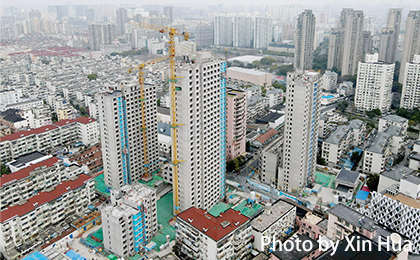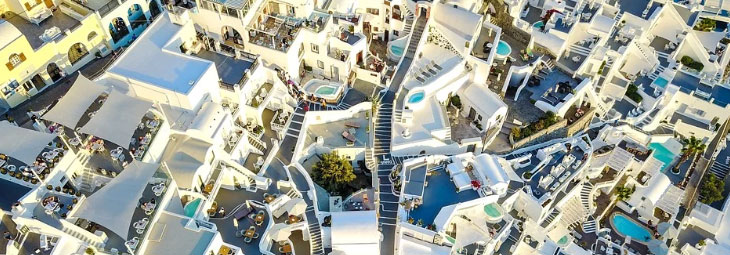


2.4 Promoting the renewal and transformation of old neighborhoods, old factories and urban villages.
Promote the conversion of functions, upgrading of business forms and enhancement of vitality in old neighborhoods, and create a number of vibrant neighborhoods according to local conditions. Renovate and upgrade commercial pedestrian streets and old commercial streets, improve supporting facilities, optimize traffic organization, enhance the quality of public space, enrich commercial forms, cultivate new types of consumption contexts, and promote cultural and tourism industries to empower urban renewal. Encourage the market-oriented approach to promote the renewal and transformation of old factories, strengthen the protection and utilization of industrial heritage, reactivate underutilized industrial zones, plant buildings and facilities, and implant new industries and new functions. Actively promote the transformation of urban villages, conduct pre-conservation assessments for historic fabric before regeneration, avoid large-scale demolition and construction, Implement customized village-level solutions-including demolition-reconstruction, rehabilitation, or hybrid approaches, effectively eliminate of safety risks and hazards, and improve the living conditions and living environment. Accelerate urban village renewal projects with strong public consensus, viable financing, and mature resettlement plans. Promote integrated revitalization of obsolete railway stations and adjacent historic neighborhoods.
2.5 Improving urban functions.
Establish and improve a multi-level, full-coverage public service network, make full use of the stock of unused housing and low-utility land, and prioritize making up for the public service gaps in livelihood sectors, and reasonably satisfy the living needs of the people. Actively and steadily push forward the construction of dual-use (peacetime-emergency) infrastructure. Improve the urban medical emergency service system, and strengthen temporary resettlement and emergency logistics system. Promote aging and child-friendly renovation, and accelerate the construction and renovation of barrier-free environments in public places. Increase the supply of universal childcare services, and develop last-resort, universal and diversified elderly care services. Construct and remodel neighborhood fitness infrastructure and facilities around the masses according to local conditions. Promote the remodeling and upgrading of consumer infrastructure. Actively expand urban public space and scientifically lay out new public cultural space.
2.6 Strengthening and upgrading urban infrastructure.
Comprehensively investigate the risks and hidden dangers of urban infrastructure. Promote the integrated development and comprehensive utilization of underground space. Accelerate the construction and transformation of underground pipelines like urban gas, water supply, drainage, sewage, heating, etc. and utility tunnels, and perfecting the long-term management system for construction, operation and maintenance. Promote the renovation and upgrading of urban water supply facilities, strengthen the construction and renovation of urban sewage collection, treatment and recycling and sludge treatment and disposal facilities, and accelerate the establishment of the integrated construction, operation and maintenance mechanism of sewage treatment plants and networks. Coordinate urban flood prevention and flood management, establish an integrated real-time control operational framework for urban watercourses, drainage networks and interconnected water bodies (rivers, lakes, reservoirs, and seas), accelerate the construction and transformation of drainage and flood prevention facilities, build a robust urban flood prevention and drainage system, and enhance the ability to deal with emergencies. Promote the renovation and upgrading of domestic waste disposal facilities. Strengthen the construction of public fire-fighting facilities and build disaster prevention infrastructure with appropriately ahead-of-demand capacity. Improve the urban transportation infrastructure, develop rapid arterial transportation, life-oriented distribution transportation and green slow-moving transportation, and accelerate the construction of parking facilities. Optimize the planning and design of urban freight transport networks and improve the system of graded distribution facilities. Promote the construction of new urban infrastructure, deepen the application of building information modeling (BIM) technology, and implement the construction of urban infrastructure lifeline safety projects.
2.7 Repairing urban ecosystems.
Insist on promoting the management of mountains, water and cities as a whole, and constructing a continuous and complete urban ecological infrastructure system. Accelerate the restoration of damaged mountains and coal mining subsidence areas, and eliminate potential safety hazards. Promote the construction of sponge cities, protect and restore urban wetlands, consolidate the effectiveness of urban black and odorous water bodies, and promote urban soil and water conservation and the construction of eco-clean small watershed development. Strengthen the risk control and remediation of soil pollution on construction land, and ensure the safe reuse of polluted land. Continuously promote the construction of urban green belts, green corridors, green wedges and greenways, improve the application level of native plant species, protect urban biodiversity, increase the number of community parks and pocket parks around the masses, and promote the opening and sharing of parks and green spaces.
2.8 Protecting and inheriting urban history and culture.
Connect with the national cultural relics census and carry out a solid survey of urban cultural heritage resources. Implement the requirement that “No more demolition in historic urban areas”, conduct a comprehensive survey of old towns and their historical and cultural districts, map out the cultural heritage resources of old residential compounds, old neighborhoods, and old factories in cities and towns, and delineate the strictest scope of protection. Carry out cultural heritage impact assessment, and establish a sound protection mechanism of “investigation before construction” and “archaeology before land transfer”. Strengthen the management of demolition of old buildings, refrain from arbitrarily demolishing old buildings and ancient dwellings with conservation value, and prohibit replacing authentic fabric with replicas. Establish a protection implementation mechanism with residents as the main body, promote the restoration of historical and cultural neighborhoods and the repair of immovable cultural relics and historical buildings, and explore ways and paths to rationally utilize cultural heritage. Protect place names with important historical and cultural values and embody the Chinese historical cultural context, and steadily standardize non-compliant place names. Strengthen streetscape control in key urban renewal areas and significant precincts, and strictly manage oversized public buildings and ultra-high-rise buildings.
Source: https://www.gov.cn/zhengce/202505/content_7023882.htm
Editor & Translator: Yin Dou